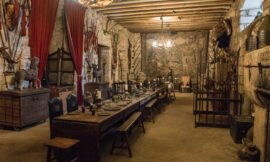Belgrade Fortress, known locally as Kalemegdan Fortress, is a historic landmark and cultural treasure located in the heart of Belgrade, Serbia. Situated at the confluence of the Sava and Danube rivers, the fortress has played a central role in the city’s history for over two millennia, serving as a strategic military stronghold, royal residence, and symbol of Serbian resilience and heritage.
The origins of Belgrade Fortress date back to ancient times, with the earliest known settlement on the site dating to the 3rd century BC. Over the centuries, the fortress was conquered and rebuilt numerous times by various civilizations, including the Celts, Romans, Byzantines, and Ottomans, each leaving their mark on its architecture and design.
One of the most iconic features of Belgrade Fortress is its imposing walls and fortifications, which stretch for over 2.5 kilometers (1.6 miles) around the perimeter of the site. The fortress is divided into the Upper Town and the Lower Town, each containing a wealth of historic buildings, monuments, and attractions.
At the heart of the fortress stands the Belgrade Fortress Park, a sprawling green space that offers panoramic views of the city, the rivers, and the surrounding countryside. The park is a popular destination for locals and visitors alike, who come to relax, stroll, and enjoy outdoor activities amidst the historic surroundings.
Within the fortress complex, visitors can explore a multitude of historic buildings, museums, and cultural sites. One of the most prominent structures is the Sahat Kula, or Clock Tower, which dates back to the 17th century and offers stunning views of the city from its observation deck. Nearby, the Nebojša Tower, a medieval fortress turned art gallery, showcases contemporary Serbian art and culture.
Another highlight of Belgrade Fortress is the Kalemegdan Park, a vast green oasis that surrounds the fortress walls and offers a tranquil retreat from the bustle of the city. The park is home to several gardens, monuments, and sculptures, as well as the iconic Victor Monument, a symbol of Serbian victory and independence.
In addition to its historic and cultural significance, Belgrade Fortress is also a vibrant cultural hub that hosts events, concerts, and festivals throughout the year. From open-air concerts to art exhibitions to historical reenactments, the fortress provides a dynamic space for locals and visitors to come together and celebrate the city’s rich heritage and cultural diversity.
In conclusion, Belgrade Fortress is a true gem of Serbia, a historic landmark that embodies the spirit and resilience of the Serbian people. With its ancient walls, picturesque surroundings, and vibrant cultural scene, the fortress remains a beloved symbol of Belgrade’s past, present, and future, inviting visitors to explore its storied history and experience its timeless beauty.



